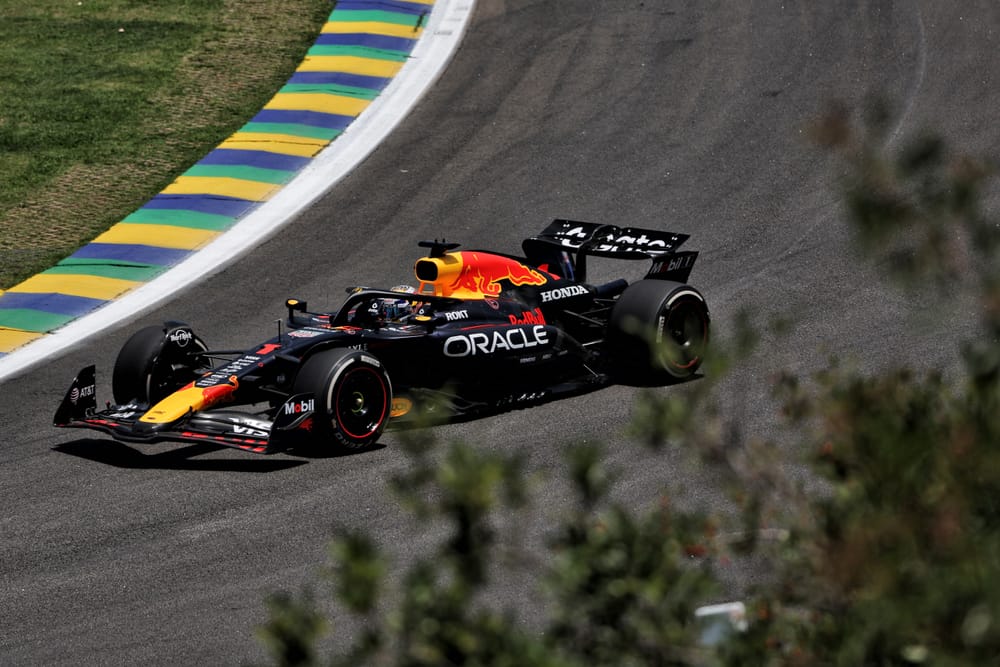First day around Interlagos with the current Formula 1 sprint format and if you hit the track running, you're likely to get a good grid position for sprint qualifying.
No time to try both the medium and soft tyres in the morning, a track demanding the rear ride height be lifted a little more than usual, and a compromise to be chosen between wing levels, plank wear and weather forecast for Saturday. That's enough to mix things up, with little chance to correct if the car is not in the ballpark immediately.
By the standards of each, McLaren, Mercedes and Aston Martin were quick immediately in FP1. Red Bull and Ferrari were in trouble.
That carried through into sprint qualifying where Lando Norris took pole, narrowly faster than Kimi Antonelli's Mercedes and the other McLaren of Oscar Piastri. Fernando Alonso almost equalled George Russell's Mercedes time in his Aston Martin but outqualified Max Verstappen, while only one Ferrari (Charles Leclerc's) made it into SQ3.
Red Bull has chosen to run Verstappen with relatively little wing and he's McLaren-quick in sectors one and three. But the McLaren is running plenty of wing and is therefore quick in the middle sector, where the understeering Verstappen just bleeds laptime away.
"I don't have the grip in the middle sector," he reported afterwards. "I can't get the car to rotate but at the same time I don't have much support from the rear."
If that sounds like the mediocre version of the Red Bull seen before its updates from Zandvoort onwards, that's probably to do with how the Interlagos circuit demands bigger rear ride heights than usual.
The RB21 derives its performance from great high-speed aero - so long as the ride height is nicely low. Without that, the high-speed downforce advantage disappears and without that, the big front wing can't really be used to help the low-speed understeer, as it will bring too much rear instability at higher speeds.
So why not a bigger wing? Then you run into plank wear problems.
So, trapped in that puzzle, if you were Red Bull, you might well turn to the car's other key strength: its great efficiency at low wing levels. But that's not there either with the underfloor not delivering well at these ride heights. There's quite possibly a solution to the Rubik's Cube puzzle, which we may see in qualifying proper and the Brazilian Grand Prix itself, but it wasn't reachable on the Friday with so little prior running.
"The car isn’t behaving as we expected here, especially on the soft tyre. On that compound the car looks like something is wrong with it and is not performing," Red Bull technical director Pierre Wache said.
"We are looking into a lot things overnight to see if we have to change something. We are investigating what the issue is, it’s across both cars and we are aiming to have the car in a better window for the rest of the weekend."
The opposite trait to that is the Aston Martin, a car which doesn't have the ultimate downforce or efficiency but which responds well to big wings, partly because it doesn't lose as much downforce as most others when the rear is lifted to protect the plank. The Alpine has similar traits - and Pierre Gasly was going much better than usual (eighth in SQ1 but then failing to make SQ3).
McLaren's plank wear is always much further forwards than on other cars (typically right beneath the driver's seat), a consequence of an aero platform out of reach to the others, stiff enough at the back that the front of the car be run low enough to give a centre of aero pressure more favourable to a big spread of corner speeds. And better able to tolerate a rear ride height increase.
That - and its tyre usage - is why its sweet spot is wider than the others. Which was perfect for a sprint qualifying lap around Interlagos. Norris, riding his confidence, was flawless. Piastri, still rebuilding from a couple of bruising weekends, was not far off. But definitely behind. As he often is on Fridays with the track grip low.

The gap was enough for Antonelli to thrust himself between them. The Mercedes was carrying more wing than Red Bull, a little less than McLaren, and on the soft tyre used in SQ3 was dynamite in the slowish middle sector, rotating well into the turns and really getting the power down well out of them. It appears to have the best traction of all and were it not for an overconfident approach into Turn 10, Antonelli may even have threatened Norris's pole.
Ferrari was nowhere, for reasons the team is struggling to fully understand. But historically, it's not a car which responds well to having its rear raised. Lewis Hamilton was looking marginally quicker than Leclerc, but couldn't deliver in SQ2. Leclerc spun in SQ2 and Hamilton himself had spun in FP1 after the rear bottomed out over the Juncao kerbs.
The forecast of heavy rain and strong winds suggests further randomising in the sprint. The big points come later - and after everyone has had more of a chance to unlock their puzzles.



